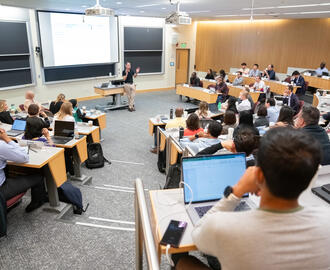For most of her career, Valentina Videva Dufresne, EMBA ’21, believed that success meant excelling in the roles she held and advancing step by step within a flat organizational structure. As a seasoned engineer and accomplished leader at Sensata Technologies, she had achieved more than many dream of— leading initiatives and driving significant growth.
However, the organizational environment she worked in, where roles like Vice President were often seen as the ultimate achievement, shaped her understanding of what was possible. Becoming a President or CEO felt distant—more for others than for her. That changed when she entered the MIT Executive MBA. The experience helped her unshackle her mindset, redefining what she believed was possible.
Today, Valentina is the President of North America and a Group Executive Committee member at Zehnder Group, where she drives innovation and growth focusing on healthy indoor climate solutions.
Did you ever imagine yourself in the position you are in now, leading as a President at Zehnder and sitting on a group executive committee?
No, not at all. When I started my career, I didn’t see a role like this as a possibility for someone like me. It wasn’t a lack of ambition—I was always driven to excel in whatever role I held and to contribute meaningfully to my team and organization. But the environments I worked in shaped my perspective on what was achievable.
Valentina Videva Dufresne, EMBA '21
At Sensata Technologies, the organizational structure was very flat, and even being promoted to director felt like an enormous achievement. At Texas Instruments, where I started, being elected to the technical ladder was a huge honor—only about 5% of the engineering population achieved that recognition. At the time, I thought, “This is amazing.” I was proud of what I had accomplished and focused on mastering each role, without necessarily looking beyond the horizon of what was right in front of me.
When I transitioned from a technical role into a P&L position, it was a deliberate choice to grow and expand my skill set, but even then, I didn’t have a clear picture of what the top could look like for me. I remember seeing my CTO’s corner office with its beautiful glass windows and thinking, “If I make it here, that’s it.” So, when I finished the MIT program and was promoted to a VP GM role with that corner office, I had a moment of reflection: “Is this it?”
It wasn’t. Before MIT, I thought maybe I could become a Vice President. It was about excelling at the role I had and doing the best possible job. But during my time at MIT, I started to ask, “Why not President? Why not CEO?” That’s when it hit me—I did have the right to sit at the table, to lead at the highest levels, and to make an impact far beyond what I had originally imagined.
I was emboldened and inspired by the MIT Sloan mission “to develop principled, innovative leaders who improve the world.” It helped me see that leadership is more than reaching the top—it’s about what you do once you get there and how you use your influence to make a difference.
How did the MIT EMBA program help you break through those limits?
The program was pivotal in helping me see beyond the barriers I had placed on myself. It wasn’t just about learning technical or leadership skills—it was about rethinking my own narrative. The cohort, the professors, and the curriculum all pushed me to see that my experiences and capabilities were just as valuable as anyone else’s in that room. I realized that I wasn’t just an engineer who could lead; I was a leader, full stop.
That shift in perspective gave me the confidence to aim higher. I remember thinking, “If I’ve come this far, why should I stop now?” The program unshackled me from those internal doubts and made me believe I could lead at the very top. And now, I am humbled to have been elected as the President for North America for Zehnder Group and a member of the Group Executive Committee, which is C-suite equivalent.
How did the EMBA program influence your leadership style?
The MIT EMBA taught me to lead with both confidence and humility. One of the most profound lessons was understanding the importance of systems thinking in leadership. It’s not just about managing your immediate team or solving today’s problems—it’s about seeing how decisions ripple through an organization and beyond. For example, through courses like Organizational Processes, I learned to consider the cultural and political aspects of decisions, not just the logical or data-driven ones. That awareness has helped me build trust across diverse teams and foster a sense of shared purpose.
Another critical shift was embracing vulnerability as a leader. Early in my career, I thought being a leader meant always having the answers. But the program—and my cohort—taught me the power of asking questions, admitting what I don’t know, and creating space for others to contribute. It’s made me a better collaborator and helped me unlock the potential of my teams.
How did the program shape your approach to problem-solving?
One of the most valuable lessons from the program was learning to frame problems effectively. In Organizations Lab (O-Lab), we were constantly challenged to ask, “What problem are we really trying to solve?” It sounds simple, but so often, people jump to solutions without fully understanding the issue. This approach has become a cornerstone of how I lead.
When I joined Zehnder, the team was already hard at work gathering data for an upcoming board presentation on our North America ventilation strategy. The team had done an impressive job collecting a wealth of information, but they faced challenges during an earlier presentation in making the data resonate. As I reviewed the presentation, I noticed there was a lot of valuable data but an opportunity to present it in a way that told a clear and compelling story. Questions like “What are we solving for?”, “Why is this important?”, and “How does this align with the company’s vision, mission, and overall strategy?” hadn’t yet been fully addressed. Drawing on tools from the Competitive Strategy and Communication and Persuation with Data classes, I worked to streamline the message—focusing on clarity and storytelling rather than overwhelming the audience with numerous graphs and excessive detail.
The story we presented used the same strong foundation the team had built, with just a few adjustments to structure and emphasis. This collaborative effort ensured the team's great work was showcased effectively, and I made a point to highlight their contributions during the presentation. The result? The board wholeheartedly approved the strategy and even asked if we could go faster, if possible, is a testament to the strength of our collective work.
Looking back, how do you define success now compared to before the program?
Before the program, I equated success with doing the best job possible. That drive to excel naturally led to promotions and a strong career trajectory. I also invested in mentoring and community work because giving back was important to me.
Today, my perspective has shifted. Success is about the responsibility that comes with leadership and the ripple effect of influence—not just within my organization but in the broader community. With greater influence comes greater responsibility, and I see it as my duty to use that influence to empower others and drive positive change. It’s not just about reaching the top; it’s about what you do once you’re there and how you use your position to create an even more meaningful impact.
Related Posts



